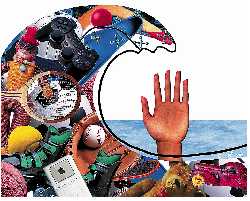|
organized
outlook
- HARRIET SCHECHTER
Make conquering clutter child’s
play for youngsters
Illustration Cristina
Martinez
It
has been said that “insanity is hereditary — you get it from your
kids.”
Nowadays
you could say the same thing about clutter.
Of course,
children and messes have always gone together like peanut butter and jelly.
But
now more than ever before, parents face a never-ending tidal wave of “must-have”
toys, games and products for kids of every age from toddlers to teenagers.
Previous
generations had it easy: They didn’t need to contend with things like Nintendo,
CDs, DVDs and all the other trendy technological marvels accompanied by innumerable
peripherals and paraphernalia.
These
days it’s not only the typical “messy” child who is overwhelmed
with excess stuff. Even your most organized offspring may
have a tough time keeping their things in order when there is too much to maintain.
So
what’s a clutter-concerned parent to do? Here are some tips to help you
manage the mess and also train children of any age to be more organized.
1.
Categorize: Putting similar items together is one of the basic rules of organization
because it’s the simplest way to keep things in a semblance of order. Typical
categories of kid stuff include toys, games, books, art supplies, computer-related,
music-related, school-related, clothing, accessories, hobbies and collections.
Categories with the
largest number of items should be subcategorized.
2.
Make it easy: The easier it is to do something, the more likely that thing is
to get done. So make it easy to:
•
Put stuff away — by having accessible
containers and appropriate furnishings that are easy for your children to use.
Example: Shelves with clear plastic or wire-mesh bins provide see-through storage
options and simple solutions for getting toys and other items up off the floor.
(Safety
note: Make sure shelving is child-safe if you have toddlers or climbers.)
•
Hang up clothes — by putting up clothes hooks at kid-friendly heights in
thoughtful places, making it easy for children to hang frequently used items
of clothing instead of dropping them on the floor. This also helps discourage
the habit of putting not-yet-dirty clothes in the laundry, something that many
kids — and adults — do because it’s easier than putting clothing
on a hanger or folding it.
(Safety
note: Avoid locating eye-level hooks on the back of doors that swing open.)
•
Throw things out —
by placing trash receptacles in convenient places, making it easy for everyone
to discard wrappers, tissues, junk mail and any other detritus that tends to
get dropped on the floor. Treat your wastebaskets like babies — keep them
within close reach at all times, feed them frequently and change them often.
3.
Provide tools: It’s hard to do any job without the right tools, and organizing
is no exception. A few basic products for clutter-proofing
kids’ rooms:
•
Bins and baskets — Even the youngest children
can be taught how to categorize and color-code by designating different colored
containers for
various types of toys, games and supplies.
•
File tote — A portable file box —
the kind with a handle on the lid — gives kids a manageable way to organize
their school papers and extracurricular projects from an early age. Help them
decide on file names, then clearly label the folders (bright-colored hanging
files are easy to use).
•
Desk, chair and lamp — A kid’s “home
office” should be a comfortable spot to do homework and also a good place
for storing frequently used supplies and books. Adequate lighting is an essential
yet often overlooked component; for flexible options, consider getting a clip-on,
gooseneck desk lamp.
4.
Establish rules: A few basic household maintenance rules for your children should
be enforced to keep things from getting out of hand. Decide what would be most helpful and realistic for your family.
Examples: Clear the floor before bedtime. No food or drink permitted in the
bedroom. Outside projects (anything involving paint, glue, mud, etc.) are not
allowed inside.
5.
Set limits: Teach your kids the In-Out Inventory Rule: For every new item that
comes in, another item of equal type (toy, game, etc.) must go out. At least twice a year, have a regular donation-day ritual, when
each member of your household clears out and donates excess stuff.
© 2004 Union-Tribune Publishing Co.
|